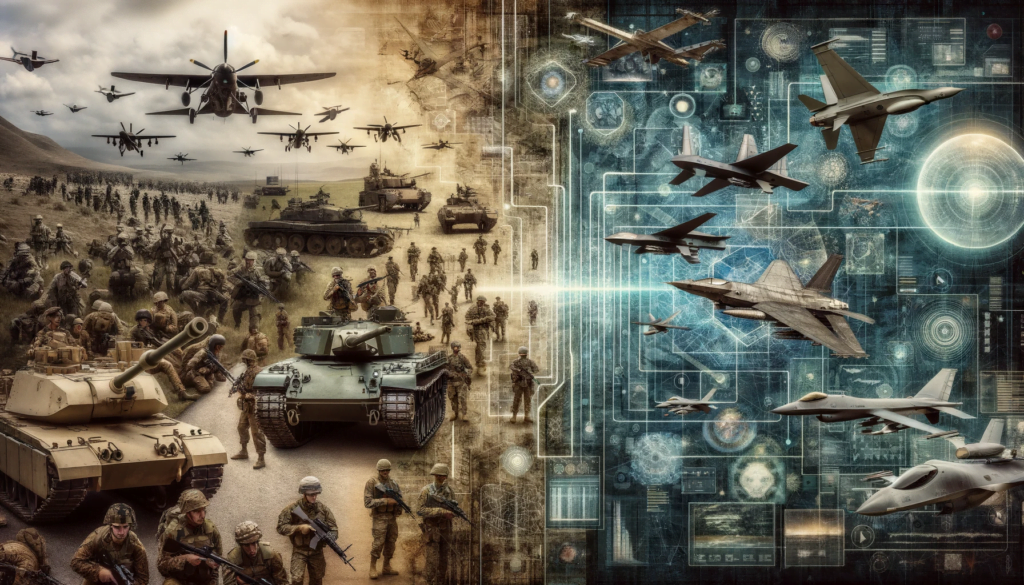The evolution of military tactics since the Second World War is a testament to how warfare has adapted to changes in technology, politics, and societal norms. World War II was a crucible of military innovation, laying the groundwork for many tactics still relevant today. This article explores the transition from the strategies of World War II to modern military practices, offering a deep dive into the pivotal shifts and enduring lessons of military history.

WWII Strategies: The Crucible of Modern Warfare
World War II was a period of intense military innovation. The German blitzkrieg, for example, combined air power, fast-moving tanks, and mobile infantry to achieve rapid victories, as seen in the early stages of the war in Poland and France. Contrastingly, the Allies’ strategic bombing campaign aimed to cripple Germany’s industrial capacity, while amphibious assaults like D-Day demonstrated the importance of large-scale, coordinated attacks involving multiple branches of the military. The Battle of Midway, a turning point in the Pacific Theater, underscored the significance of intelligence and air power in naval warfare. These strategies laid the foundations for modern military tactics, emphasizing speed, coordination, and intelligence.
Post-WWII Military Tactics: Shifting Paradigms
The post-World War II era witnessed a paradigm shift in military tactics, influenced heavily by the advent of nuclear weapons. The Cold War era’s doctrine of mutually assured destruction (MAD) exemplifies this, where the potential for catastrophic nuclear exchanges led to a focus on deterrence rather than direct conflict. The Vietnam War illustrated the rise of guerrilla tactics against conventional military forces, emphasizing mobility, local support, and knowledge of the terrain. Meanwhile, the Soviet-Afghan War highlighted the effectiveness of insurgent tactics against a technologically superior adversary, setting a precedent for future asymmetric conflicts.
Modern Military Strategies and Technologies
In the 21st century, military tactics have become increasingly sophisticated, integrating advanced technology and information warfare. Drones, like the MQ-9 Reaper, have redefined surveillance and targeted strikes, while cyber warfare has opened a new front in conflicts, as seen in the alleged Russian interference in the 2016 U.S. elections. The use of AI in military systems, such as the U.S. Department of Defense’s Project Maven, aims to enhance decision-making and operational efficiency. The 2003 Iraq War showcased the application of precision-guided munitions, significantly reducing collateral damage while increasing strike accuracy.
Comparative Analysis: WWII vs. Modern Warfare
Comparing WWII and modern warfare reveals how the scale and nature of conflict have evolved. WWII was marked by large-scale, state-on-state conflicts, exemplified by the Battle of Stalingrad’s brutal urban warfare and mass mobilization. In contrast, contemporary conflicts, like the U.S. military operations in Iraq and Afghanistan, have often involved asymmetric warfare, with state actors facing non-state insurgents, highlighting the increased importance of counterinsurgency tactics and localized engagements.
Conventional vs. Asymmetric Warfare
The transition from conventional to asymmetric warfare marks a significant shift in military strategies. Conventional warfare, as seen in WWII’s large-scale battles like the Normandy landings, involved direct confrontations between similarly equipped state armies. Modern asymmetric warfare, however, often features state armies against non-state actors using guerrilla tactics, as seen in the U.S. experiences in Vietnam and more recently in the Middle East, where insurgent groups have leveraged terrain familiarity and unconventional tactics against more conventionally powerful adversaries.
Digital and Technological Warfare: The New Frontier
The digital and technological domain has become a critical battlefield in modern warfare. Cyber operations, like the Stuxnet virus attack on Iranian nuclear facilities, demonstrate the potential of cyber warfare to sabotage critical infrastructure without traditional kinetic engagement. Similarly, the increasing reliance on space-based assets for communication and navigation has made space a new arena for military competition, as seen in the development of anti-satellite weapons by major powers.
Lessons from WWII in Contemporary Military Tactics
Despite the evolution in tactics, many lessons from WWII remain pertinent. The importance of combined arms operations and joint-force coordination, evident in the success of the D-Day landings, continues to guide military strategy. The role of intelligence, crucial in the Allied victory through efforts like the breaking of the Enigma code, is even more central in the age of information warfare. Additionally, the concept of total war, involving the mobilization of national resources, has evolved but remains relevant, as seen in the economic and information warfare components of modern conflicts.
Conclusion: Reflecting on the Dynamics of Military Evolution
The journey from the tactics of WWII to today’s warfare landscape is marked by both continuity and change. Technological advancements, shifts in global politics, and the lessons of history have collectively shaped modern military doctrine. This evolution reflects not just changes in how wars are fought but also how they are perceived and understood in a global context.
FAQs on Military Strategies
- WWII vs. Modern Warfare: The transition from large-scale state conflicts to asymmetric, technology-driven engagements marks the key difference.
- Technological Impact: Technology has redefined warfare, introducing precision strikes, drones, and cyber capabilities.
- Intelligence in Warfare: Intelligence has evolved from code-breaking and espionage to include cyber intelligence and real-time battlefield data analysis.
- Evolution of Asymmetric Warfare: Asymmetric warfare has grown in prominence, reflecting the changing nature of global conflicts and the tactics of non-state actors.
- Cyber Warfare’s Role: Cyber warfare has become a critical component of national security, influencing everything from election security to critical infrastructure.
- WWII Lessons in Modern Warfare: Strategic and tactical lessons from WWII, including the importance of combined arms and intelligence, continue to influence modern military doctrine.
- Global Politics and Military Strategy: Post-WWII shifts in global politics, such as the Cold War and the rise of non-state actors, have profoundly influenced military strategies.
Insights: Further Exploration into Military Tactics Evolution
For those seeking a deeper understanding of the evolution of military tactics post-World War II, here’s a curated list of resources offering valuable insights. These resources range from academic studies to documentaries, each providing a unique perspective on the changing nature of warfare.
- Books and Publications
- The Evolution of Modern Land Warfare: Theory and Practice by Christopher Bellamy – This book offers an in-depth analysis of the changes in land warfare post-World War II, covering various conflicts and technological advancements.
- On War by Carl von Clausewitz – Although written in the early 19th century, Clausewitz’s theories on military strategy and tactics remain influential and are often referenced in discussions about modern warfare.
- Academic Journals
- Journal of Strategic Studies – This peer-reviewed academic journal covers a wide range of topics related to military strategy, including historical analyses and contemporary assessments.
- Military Operations Research – Focusing on the application of quantitative methods in military decision-making, this journal provides insights into the technological aspects of modern warfare.
- Documentaries and Films
- The Fog of War: Eleven Lessons from the Life of Robert S. McNamara – This documentary provides a unique perspective on military strategy through the lens of the former U.S. Secretary of Defense during the Vietnam War.
- World War II in Colour – Available on various streaming platforms, this series offers a vivid look at WWII, providing a base for understanding the evolution of tactics into the modern era.
- Online Resources and Databases
- Council on Foreign Relations (CFR) – The CFR website hosts numerous articles and reports on contemporary military strategies and global security issues.
- GlobalSecurity.org – This comprehensive resource provides detailed information on military capabilities, defense policies, and global security issues.
- Military Think Tanks and Research Institutes
- RAND Corporation – Known for its research in defense and security, RAND offers reports and papers on a range of topics, including military tactics and technology.
- International Institute for Strategic Studies (IISS) – IISS provides in-depth analysis and data on global military capabilities and defense economics.
Insider Release
Contact:
DISCLAIMER
INSIDER RELEASE is an informative blog. This blog discusses various topics. It is emphasized that the ideas and concepts, although based on research from official sources, result from free evaluations by the writers. The BLOG, in full compliance with the principles of information and freedom, is not classified as a press site.










Yeah the six points definitely will be the next factor of warfare but the classic never change , using traditional methods as simple as possible might still work
Certainly, your observation brings an interesting perspective to the discussion. It’s true that while modern warfare is rapidly evolving with advanced technology and strategic approaches, as outlined in our article “Transforming Warfare: The Evolution of Military Tactics Post-World War II”, there’s an enduring relevance to traditional methods. The simplicity and proven effectiveness of classic tactics cannot be overlooked, even in an era where new dimensions like cyber and space are becoming increasingly significant. Balancing innovation with time-tested strategies is indeed key to adapting and thriving in the ever-changing landscape of military conflict.
Wow, the way military tactics have evolved since WWII is fascinating! From massive tank battles to cyber attacks and drones, it’s like we’re living in a completely different era of warfare. It’s intriguing (and a bit scary) to see how technology and strategy have advanced, making conflicts more complex than ever. Makes you wonder what’s next in military evolution.
Absolutely, your enthusiasm for the topic shines through, and you’re spot on about the dramatic changes in military tactics! It’s almost like we’re in a sci-fi movie when you compare today’s cyber warfare and drone technology to the tank battles of WWII. The pace at which military strategy and technology have evolved is truly staggering, adding layers of complexity to modern conflicts. It does leave us wondering about the future of warfare and how further advancements will shape the battlefield. Your curiosity and insights are exactly what we love to see from our readers. Thanks for diving into the discussion and sharing your thoughts!